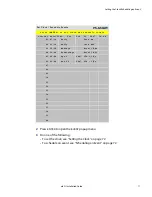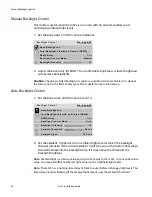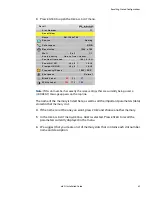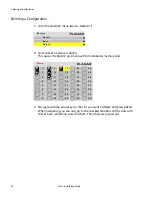
Saving and Recalling Configurations
m52L Installation Guide
83
Saving and Recalling Configurations
Some settings are saved automatically, but there are big advantages to saving a
configuration manually. You can use the 40 numbered memory “slots” to save and
recall settings, which is the fastest way to change configurations.
Some display settings (such as position, brightness/contrast, and color balance) are
saved automatically five seconds after you make a change. The display caches the
last ten settings. Whenever a picture is shown from a new source with the same
resolution as a previous picture, the display recalls the previous settings rather than
readjusting everything. This happens regardless of the check marks in the
AUTO
SETUP
OPTIONS
menu. (See "Auto Setup Options" on page 67
)
For example, suppose you display an NTSC picture in the composite input and set the
Brightness to your liking. Then you feed in a composite PAL picture and set a different
Brightness. If you then send a new NTSC picture, the previous NTSC picture’s settings
for Brightness are used.
Note:
Aspect Ratio is specific to the source, which means it applies to all modes. It does not
change when the system recalls a memory from cache.
How Automatic Save Works
Whenever you change settings on the display with the remote control or RS232
commands, they are saved automatically. If you change to a new source (switch to
another input connector) then switch back to the previous source, everything you
did before will be “recalled.” Things will look like they did before.
Suppose you make adjustments to an SVGA source on analog, then you feed a UXGA
source to analog and make new adjustments. Then you switch to the S-Video
connector and do some more setup for it. Later, you switch to the analog input again,
and this time it has the SVGA source from before. The display will recognize that it
has seen this source before, or at least a source with these characteristics, and will
recall the SVGA settings you established before.
The settings recalled by Automatic Save include Input Levels, Position and
Frequency. However, Wall Mode and Big Picture adjustments are not saved with
Automatic Save. Those settings can only be recalled from memory slots.
The fastest, most efficient way to change from one source to another, or to change a
wall from individual pictures to one big picture, is to recall a memory.
Advantages of Saving Configurations to Memory Slots
• You can compare multiple settings quickly
• You don’t have to repeat settings when comparing entire configurations
• You can revert to a known good setting when testing new configurations
Summary of Contents for m52L
Page 1: ...m52L Installation Guide ...
Page 2: ......
Page 4: ...iv m52L Installation Guide ...
Page 10: ...Table of Contents vi m52L Installation Guide ...
Page 20: ...Tools and Other Things You May Need 10 m52L Installation Guide ...
Page 28: ...Lining Up Screen Brackets 18 m52L Installation Guide ...
Page 32: ...About UPS Supplies 22 m52L Installation Guide ...
Page 58: ...Sharpness Settings 48 m52L Installation Guide ...
Page 60: ...Picture Position 50 m52L Installation Guide ...
Page 64: ...Using Planar s Big PictureTM 54 m52L Installation Guide ...
Page 68: ...Viewport Adjustment 58 m52L Installation Guide ...
Page 74: ...Tips for Color Balancing 64 m52L Installation Guide ...
Page 88: ...Turn Backlight Off With No Source and DPMS Delay 78 m52L Installation Guide ...
Page 92: ...Controlling With RS232 Commands 82 m52L Installation Guide ...
Page 102: ...Deleting a Configuration 92 m52L Installation Guide ...
Page 106: ...Where to Go From Here 96 m52L Installation Guide ...
Page 116: ...106 m52L Installation Guide ...
Page 118: ...Rear View 108 m52L Installation Guide Rear View 0 3 0 7 5 7 2 7 21 0 00 3 ...
Page 120: ...110 m52L Installation Guide ...
















































